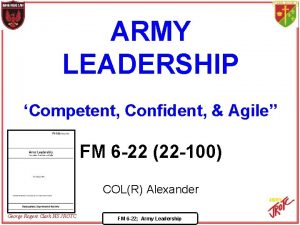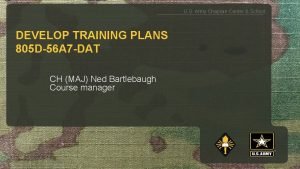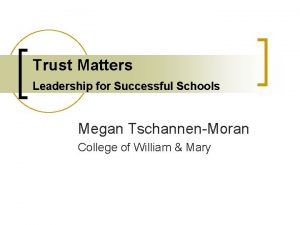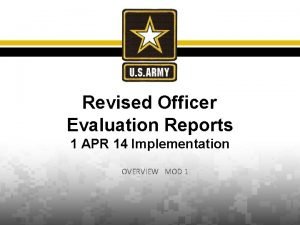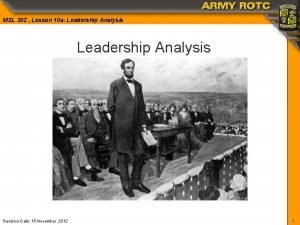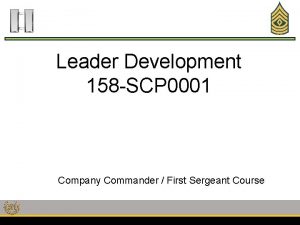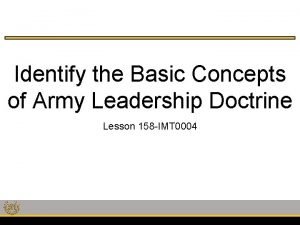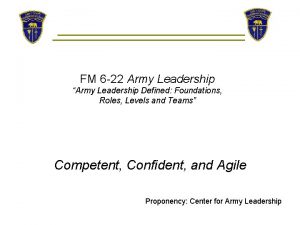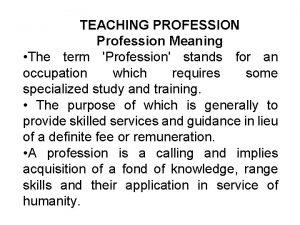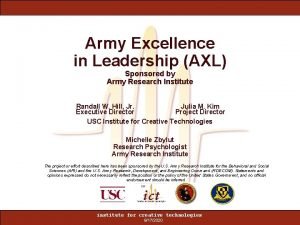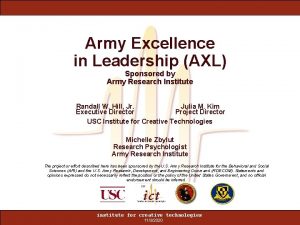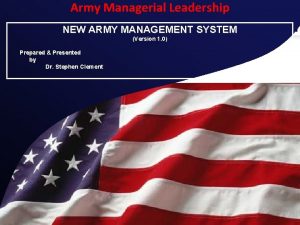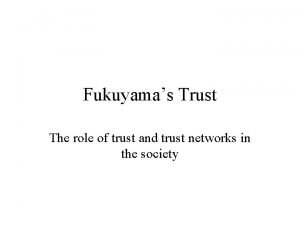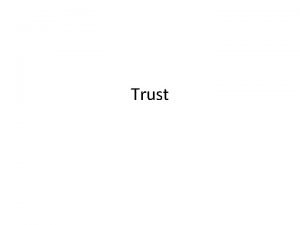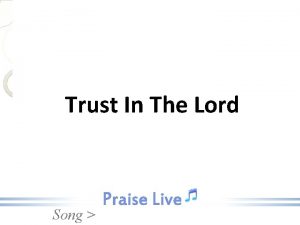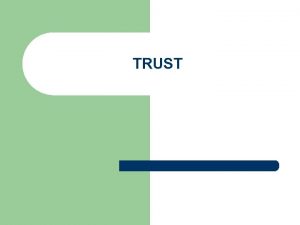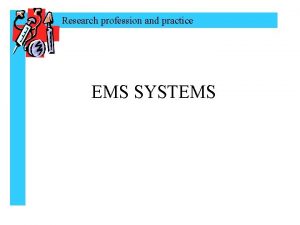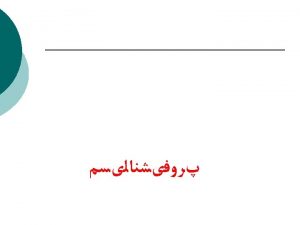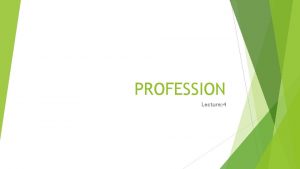AP 140 Army Leadership and the Profession Trust




























- Slides: 28

AP 140 Army Leadership and the Profession

Trust Matters in Three Ways

Learning Objective • Action: Apply Army Ethical standards to decision making. • Conditions: As a student and leader attending the CCC, using a direct-level leadership perspective in notional, tactical, and operational environments, given references, practical exercises and classroom discussions. • Standard: Make a decision using the Army’s “Ethical Lenses” (Perspectives). • Analyze Trust and the Army Profession • Examine Identity and the Army Profession • Describe the Army’s Framework for Character Development • Analyze the Army Values • Contrast Army Culture and Unit Climate • Apply Ethical Reasoning • Learning Domain: Cognitive • Level of Learning: Applying

Lesson Scope • In this three-hour lesson, learners examine Army leadership and the Army Profession with a focus on building mutual trust. • Learners will analyze: the Army Profession; identity, climate, and culture; and mutual trust in small units. • Learners will examine an ethical reasoning model and use a case study to apply ethical reasoning in a realworld scenario. • The desired outcomes of this lesson are for learners to understand the Army Profession and apply ethical reasoning based the Army Values within their decision making.

The Army Profession • The Army Profession is a vocation of Soldiers and Department of the Army Civilians whose collective expertise is the ethical design of, support to, and application of landpower; serving under civilian authority; and entrusted to defend the Constitution and the rights and interests of the American people. • The Army Profession is unique because of its responsibilities related to the ethical application of violence on a large scale on behalf of the Nation. The Army Values guide the Army Profession. • Reference: ADP 6 -22 para 1 -7 (31 July 2019)

Characteristics of a Profession • Professions share essential characteristics. Professions— • Are a full-time occupation. • Possess training or education programs relative to the field. • Have a distinct body of knowledge. • Operate within established ethics. • Are self-policing. • Reference: ADP 6 -22 para 1 -8 (31 July 2019)

Identity and the Army Profession • Everyone has an identity or a way they see themselves. • Leaders internalize the roles, responsibilities, and actions that they understand of a leader to be, know, and do. • Leaders who are unsure of themselves filling the role of a leader will be limited until they have confidence. • Without a clear leader identity, others will question the type of leader they are, what they stand for, and the way they conduct themselves. • Reference: ADP 6 -22 para 1 -32 (31 July 2019)

The Army Framework for Character Development

Trust and Mission Command • Successful mission command is enabled by the principles of— • • Competence Mutual trust Shared understanding Commander’s intent Mission orders Disciplined initiative. Risk acceptance Reference: ADP 6 -0 para 1 -26 (31 July 2019)

The Army Values • Loyalty • Duty • Respect • Selfless service • Honor • Integrity • Personal courage

Army Culture and Unit Climate

Ethical Climate Assessment Survey

Indicators of a Professional Climate and Mutual Trust • • • Teamwork, fair play, and information sharing Open, candid communications Soldier job satisfaction Soldiers and families attend unit social/sports activities Reenlistment rates are high Clear priorities and goals are set There is a fair system of recognition, reward, and punishment Leaders have the courage to admit when they are wrong Leaders actively seek input from subordinates Leaders act on feedback they have been provided Leaders have the authority to make decisions when they are consistent with commander’s intent or guidance • Leaders lead by example and serve as good role models • Leader behavior is consistent with the Army Ethic and Army Values • Leaders lead from the front, sharing hardship

SH/SA Continuum – Impacts on Readiness

How to Strengthen Mutual Trust in Your Unit Start with yourself Create transparency Provide clear intent Keep commitments Listen Demand accountability of yourself & others Set the example Make decisions and actions consistent with the Army Ethic Demonstrate the Army Values Demonstrate respect Extend trust Start with why Explain your identity Explain your vision Clarify expectations To subordinates To peers To superiors, coaches and mentors Open, candid communications Confront reality – state truth Build consensus Engage Soldiers in being part of the solution Match your deeds to your words Build confidence by doing – deliver results Balance subordinate needs with mission requirements Right wrongs, resolve conflict, and foster teamwork Set high standards Enforce them fairly and consistently Hold yourself to those same standards Share hardship with your Soldiers

Moral Challenges

Ethical Reasoning Model

Using the Ethical Lenses

Develop • How could you use what you’ve learned today in the future? • How will you make decisions in the future? • How can you develop your subordinates to make right decisions?

Practical Exercise: Collateral Case Study Intro

Practical Exercise: Collateral Case Study Conclusion

Practical Exercise: Confronting Unethical Conduct on Social Media

Reflection / Summary • How could you use what you’ve learned today in the future? • How will you make decisions in the future? • How can you develop your subordinates to make right decisions?

Back-up Slides • Instructor note: Slides 25 -28 are provided as additional information. • These slides serve as a precursor future blocks of instruction, namely: • MC 100 Mission Command • O 100 Operations • OP 100 The Operations Process. • Students should make the connections between the Army Profession and future classes as they work through CCC.

The Army’s Four Strategic Roles • Readiness for ground combat is and will remain the U. S. Army’s first priority. • The Army accomplishes its mission by supporting the joint force in four strategic roles: 1. Shaping operational environments 2. Preventing conflict 3. Prevailing in large-scale ground combat 4. Consolidating gains • The strategic roles clarify the enduring reasons for which our Army is organized, trained, and equipped.

US Army Core Competencies • Prompt and sustained land combat. • Combined arms operations • Combined arms maneuver and wide area security. • Armored and mechanized operations. • Airborne and air assault operations. • Special operations. • Set and sustain theater for the joint force. • Integrate national, multinational, and joint power on land.

Competence and Mission Command • An organization’s ability to operate using mission command relates directly to the competence of its Soldiers. • Commanders and subordinates achieve the level of competence to perform assigned tasks to standard through training, education, assignment experience, and professional development. • Commanders continually assess the competence of their subordinates and their organizations. • This assessment informs the degree of trust commanders have in their subordinates’ ability to execute mission orders in a decentralized fashion at acceptable levels of risk

Mutual Trust and Mission Command • Mutual trust is shared confidence between commanders, subordinates, and partners that they can be relied on and are competent in performing their assigned tasks. • There are few shortcuts to gaining the trust of others. • Trust is given by leaders and subordinates, and built over time based on common shared experiences. • It is the result of upholding the Army Values, exercising leadership consistent with Army leadership principles, and most effectively instilled by the leader’s personal example.
 Army leadership styles
Army leadership styles Charitable work
Charitable work Usachcs
Usachcs Transformational vs transformative leadership
Transformational vs transformative leadership Trust matters leadership for successful schools
Trust matters leadership for successful schools Army oer support form example
Army oer support form example Army leadership requirements model
Army leadership requirements model Scp0001
Scp0001 Army competencies and attributes
Army competencies and attributes Foundation of army leadership definition
Foundation of army leadership definition Jjdidtiebuckle
Jjdidtiebuckle What is adaptive leadership theory
What is adaptive leadership theory Capable but cautious performer
Capable but cautious performer Which profession do you like
Which profession do you like Teaching as a vocation meaning
Teaching as a vocation meaning Panggilan hidup profesi
Panggilan hidup profesi Code of ethics for teachers article 3
Code of ethics for teachers article 3 Issues and ethics in the helping profession
Issues and ethics in the helping profession Hình ảnh bộ gõ cơ thể búng tay
Hình ảnh bộ gõ cơ thể búng tay Bổ thể
Bổ thể Tỉ lệ cơ thể trẻ em
Tỉ lệ cơ thể trẻ em Chó sói
Chó sói Chụp phim tư thế worms-breton
Chụp phim tư thế worms-breton Hát lên người ơi
Hát lên người ơi Kể tên các môn thể thao
Kể tên các môn thể thao Thế nào là hệ số cao nhất
Thế nào là hệ số cao nhất Các châu lục và đại dương trên thế giới
Các châu lục và đại dương trên thế giới Cong thức tính động năng
Cong thức tính động năng
